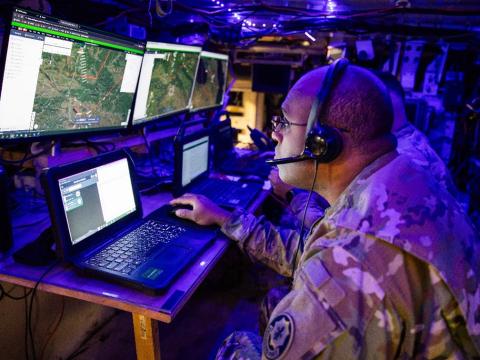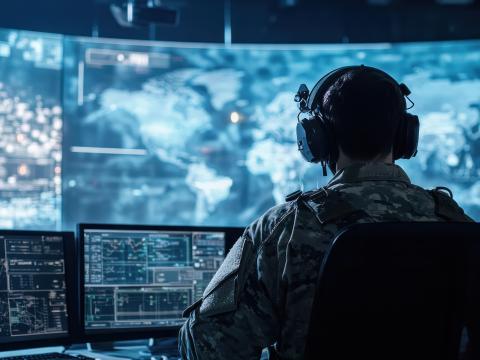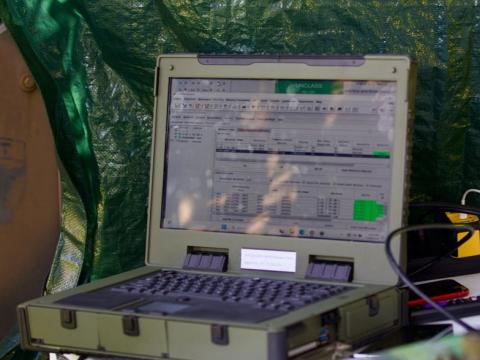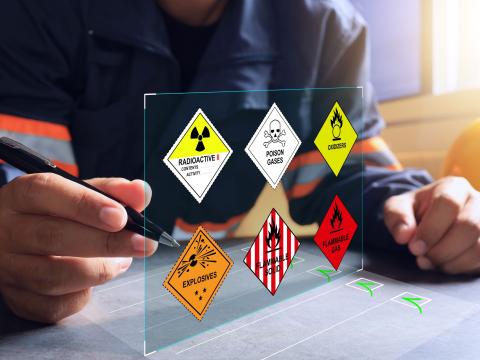Tactical Signalers Learn to Pack Light, Travel Right
Rapid reaction communicators downsize equipment to increase deployment capabilities and reduce fielding time.
The U.S. Army’s mobile signal brigade is moving at a faster pace with smaller, more capable hardware that can be deployed rapidly into a theater of operations. The increasing propensity for diverse missions set in foreign lands is impelling the requirement for comprehensive communications systems that can be established quickly in unfamiliar, or even hostile, settings.
This new capability is driven as much by opportunity as by necessity. Technological advances such as more powerful processors and devices that consume less electricity have allowed the fielding of complex multifunction equipment serving a host of military networking needs.
In some cases, vital communications hardware that needed to be introduced in large groups of 5-ton trucks now can be dropped into a distant theater of operations on the backs of smaller vehicles. Soon, a single vehicle that can be flown in on a theater transport aircraft may serve the global communications needs of a major Army deployment.
Recent technology improvements have reduced the time required for deploying a small communications satellite and switch configuration to as few as 18 hours; from 72 hours down to 48 hours for a medium configuration; and from six days to 72 hours for a large configuration.
At the center of this time and travel transformation is the Army’s mobile communications unit, the 11th Signal Brigade. Based at Fort Huachuca, Arizona, the brigade supports all of the U.S. commands worldwide. Its mission-essential task list includes providing command, control, communications and computers (C4) systems and networks; transitioning to war; and protecting and sustaining the force.
Col. Daniel Judy, USA, commander of the 11th Signal Brigade, explains that the brigade has undergone a major restructuring over the past two and a half years. Two traditional signal battalions were reorganized into mirror units, while a specialty company was created. A third battalion serves as a general support unit.
Overall, the brigade comprises four battalions. The 54th Signal Battalion is forward-deployed in Riyadh, Saudi Arabia. The others—the 40th, the 86th and the 504th—are based at Fort Huachuca.
A fifth key element, the 269th Company, is in the 86th Signal Battalion. Known as the Powerpac Company, it provides an echelons-above-corps contingency capability. It has 10 AN/TSC-93B ground mobile force (GMF) tactical satellite systems, including six new triband AN/TSC-93B units that ultimately will be replaced with more advanced triband tactical terminal units. It also includes one AN/TSC-85B GMF tactical satellite system; three line-of-sight AN/TRC-173/174 units; and two AN/TSC-155 mobile gateway vans.
The 40th and the 86th signal battalions are configured along nearly identical lines. Each features an A/B company equipped with one AN/TTC-39D triservice tactical (TRITAC) switch; one AN/TSC-85B GMF tactical satellite system; two AN/TSC-93B GMF tactical satellite systems; and four AN/TRC-170 tropospheric scatter systems. Each battalion’s C Company includes one AN/TTC-39D TRITAC switch; three AN/TSC-93B GMF tactical satellite systems; and four AN/TRC-170 tropospheric scatter systems. The battalions’ D companies include one AN/TTC-39D TRITAC switch; one AN/TYC-39A message switch; two AN/TSC-85B GMF tactical satellite systems; two AN/TRC-170 tropospheric scatter systems; three line-of-sight AN/TRC-138/175 systems; and one AN/TSC-155 mobile gateway van.
The 504th Signal Battalion is a general support element. Described by Col. Judy as unique to the whole force structure, this battalion includes a heavy cable construction company, two installation companies connected to Fort Huachuca’s information systems engineering command, and a maintenance and supply company. It also provides computer upgrade and repair, tactical installation and networking company implementation, and printed circuit board fault isolation and repair.
Capable as they may be, these systems come at a price in transportation. Most are mounted on 5-ton trucks, which limits them to deployment via giant Boeing C-17 or, most likely, Lockheed Martin C-5 transport aircraft. They take longer for the brigade to deploy, and the aircraft are limited in the selection of landing areas.
The brigade employs its large contingency communications package for extensive requirements. This package consists of an AN/TTC-39D switch teamed with a large AN/TSC-85B satellite communications van. It includes a 20-foot satellite dish and an AN/TSC-155 mobile gateway van. With its generators, this configuration can comprise five or six large trucks.
For smaller, more rapid deployments, the brigade is introducing the single-shelter AN/TTC-56 switch in July. Mounted with its generators on two high mobility multipurpose wheeled vehicles (HMMWVs), this unit features a 64-kilobit-per-second matrix switch, newer processors and integrated high-speed components such as a high-speed multiplexer (MUX) card, a tactical interface adapter, a switch multiplex unit (SMU), a Cisco 7206 router, and integrated network management. Its configuration includes two generators.
Maj. John Dewey, USA, 11th Signal Brigade operations officer, explains that the single-shelter switch will perform all of the functions of the AN/TTC-39D. As a smaller switch, the AN/TTC-56 offers slightly less in the way of connection capabilities. “With good networking, you can work around it,” he assures. “It’s a lot more deployable.
“To do that power projection, you have to move fast, and you have to be able to fit on an intratheater lift,” Maj. Dewey relates.
Another key size reduction comes with the employment of the AN/TSC-143, known as the small/medium triband communications system. It is mounted on a single HMMWV, with its generator based on an additional HMMWV. This system provides links from the strategic interface down to the user device. Users can have secure and nonsecure telephony, access to the defense switched network and the defense red switch network. Whether in a coalition or closed network, the system can provide multiplexed services. Radio services include single channel tactical satellite, Inmarsat, a single channel ground and airborne radio system, improved high frequency radio, handheld radios, and personal communications systems.
Data services include the secure Internet protocol router network (SIPRNET), the nonsecure Internet protocol router network (NIPRNET), the automated defense information network (AUTODIN) and intelligence services or the global command and control system. Video services include battlefield videoconferencing and CNN. The HMMWV system also features three satellite bands: C, X and Ku; an SMU and a Cisco router. It offers a networking capability with increased internodal trunk capacity.
Even this advanced system is only an interim solution. The super high frequency (SHF) triband advanced range extension tactical terminal, known as STAR-T, will replace the prototype AN/TSC-143. This unit will begin testing in May. It is mounted on a single HMMWV and replaces the AN/TSC-93B and the AN/TSC-85B. Equipped with onboard switches, it features a single shelter to provide satellite capability.
As with the triband unit, STAR-T also can provide the hub capability inherent in the AN/TSC-85B. It offers C-, Ku- and X-band capabilities for split-based operations, and it includes an integrated switch for interfacing with commercial and joint military switching systems. Instead of an SMU, STAR-T features a 64-kilobit Lucent integrated services digital network switch that communicates with legacy TRITAC systems via T-1 interfaces.
In addition to these size reductions, the brigade already has downsized its line-of-sight SHF and ultrahigh frequency systems from 5-ton trucks to HMMWVs. Another key addition is a 16-foot satellite dish lightweight high-gain X-band antenna.
The most significant difference between the brigade’s larger and smaller systems is their relative airlift requirements, Col. Judy points out. The two-HMMWV AN/TTC-56 single-shelter switch replaces the four-truck AN/TTC-39D. These HMMWVs can be introduced by being dropped into a theater deployment on C-130 transport aircraft, where the larger 5-ton trucks are more difficult to deploy quickly on C-17s and C-5s.
Col. Judy notes that the AN/TSC-85B and AN/TTC-39D system provides similar services to the triband system, only on a larger scale. The smaller units can provide rapid capability, and if developments require increased capacity, then more units can be added as easily as the original HMMWVs. Ultimately, the larger 5-ton truck units will be transferred to the Reserve component.
The colonel states that distinctions between communications at echelons above and below corps are fading. In an exercise in Kuwait two years ago, the brigade provided strategic communications down to the division commander. This included voice, data and video.
As this year began, the brigade was engaged in deployments in six countries. Recent activities include operations in Qatar and Kuwait, Kosovo and Italy, Egypt, East Timor and Australia, and Bosnia and Herzegovina.
Col. Judy characterizes these deployments as power projection from Fort Huachuca. “We pretty much keep engaged continuously. This power projection unit is deployed worldwide—in six countries right now,” the colonel emphasizes.




Comments